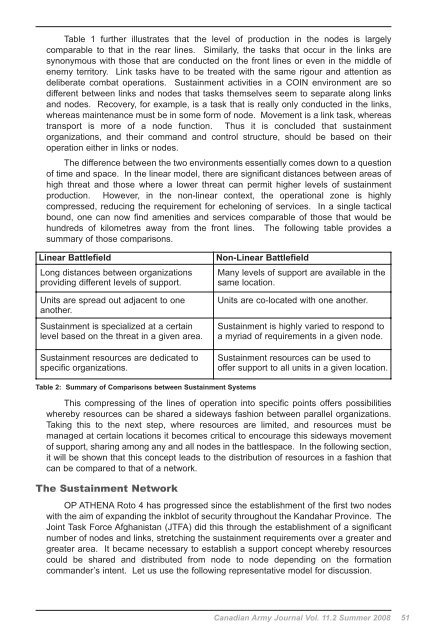Practical Sustainment Concepts for the Non-Linear Battlespace
Practical Sustainment Concepts for the Non-Linear Battlespace
Practical Sustainment Concepts for the Non-Linear Battlespace
Create successful ePaper yourself
Turn your PDF publications into a flip-book with our unique Google optimized e-Paper software.
Table 1 fur<strong>the</strong>r illustrates that <strong>the</strong> level of production in <strong>the</strong> nodes is largely<br />
comparable to that in <strong>the</strong> rear lines. Similarly, <strong>the</strong> tasks that occur in <strong>the</strong> links are<br />
synonymous with those that are conducted on <strong>the</strong> front lines or even in <strong>the</strong> middle of<br />
enemy territory. Link tasks have to be treated with <strong>the</strong> same rigour and attention as<br />
deliberate combat operations. <strong>Sustainment</strong> activities in a COIN environment are so<br />
different between links and nodes that tasks <strong>the</strong>mselves seem to separate along links<br />
and nodes. Recovery, <strong>for</strong> example, is a task that is really only conducted in <strong>the</strong> links,<br />
whereas maintenance must be in some <strong>for</strong>m of node. Movement is a link task, whereas<br />
transport is more of a node function. Thus it is concluded that sustainment<br />
organizations, and <strong>the</strong>ir command and control structure, should be based on <strong>the</strong>ir<br />
operation ei<strong>the</strong>r in links or nodes.<br />
The difference between <strong>the</strong> two environments essentially comes down to a question<br />
of time and space. In <strong>the</strong> linear model, <strong>the</strong>re are significant distances between areas of<br />
high threat and those where a lower threat can permit higher levels of sustainment<br />
production. However, in <strong>the</strong> non-linear context, <strong>the</strong> operational zone is highly<br />
compressed, reducing <strong>the</strong> requirement <strong>for</strong> echeloning of services. In a single tactical<br />
bound, one can now find amenities and services comparable of those that would be<br />
hundreds of kilometres away from <strong>the</strong> front lines. The following table provides a<br />
summary of those comparisons.<br />
<strong>Linear</strong> Battlefield <strong>Non</strong>-<strong>Linear</strong> Battlefield<br />
Long distances between organizations<br />
providing different levels of support.<br />
Units are spread out adjacent to one<br />
ano<strong>the</strong>r.<br />
<strong>Sustainment</strong> is specialized at a certain<br />
level based on <strong>the</strong> threat in a given area.<br />
<strong>Sustainment</strong> resources are dedicated to<br />
specific organizations.<br />
Table 2: Summary of Comparisons between <strong>Sustainment</strong> Systems<br />
This compressing of <strong>the</strong> lines of operation into specific points offers possibilities<br />
whereby resources can be shared a sideways fashion between parallel organizations.<br />
Taking this to <strong>the</strong> next step, where resources are limited, and resources must be<br />
managed at certain locations it becomes critical to encourage this sideways movement<br />
of support, sharing among any and all nodes in <strong>the</strong> battlespace. In <strong>the</strong> following section,<br />
it will be shown that this concept leads to <strong>the</strong> distribution of resources in a fashion that<br />
can be compared to that of a network.<br />
The <strong>Sustainment</strong> Network<br />
Many levels of support are available in <strong>the</strong><br />
same location.<br />
Units are co-located with one ano<strong>the</strong>r.<br />
<strong>Sustainment</strong> is highly varied to respond to<br />
a myriad of requirements in a given node.<br />
<strong>Sustainment</strong> resources can be used to<br />
offer support to all units in a given location.<br />
OP ATHENA Roto 4 has progressed since <strong>the</strong> establishment of <strong>the</strong> first two nodes<br />
with <strong>the</strong> aim of expanding <strong>the</strong> inkblot of security throughout <strong>the</strong> Kandahar Province. The<br />
Joint Task Force Afghanistan (JTFA) did this through <strong>the</strong> establishment of a significant<br />
number of nodes and links, stretching <strong>the</strong> sustainment requirements over a greater and<br />
greater area. It became necessary to establish a support concept whereby resources<br />
could be shared and distributed from node to node depending on <strong>the</strong> <strong>for</strong>mation<br />
commander’s intent. Let us use <strong>the</strong> following representative model <strong>for</strong> discussion.<br />
Canadian Army Journal Vol. 11.2 Summer 2008 51







![La modularite dans l'Armee de terre canadienne [pdf 1.6 MB]](https://img.yumpu.com/17197737/1/188x260/la-modularite-dans-larmee-de-terre-canadienne-pdf-16-mb.jpg?quality=85)









